This second-part article delves into Weyl’s early years at Göttingen and his mathematical-philosophical outlook
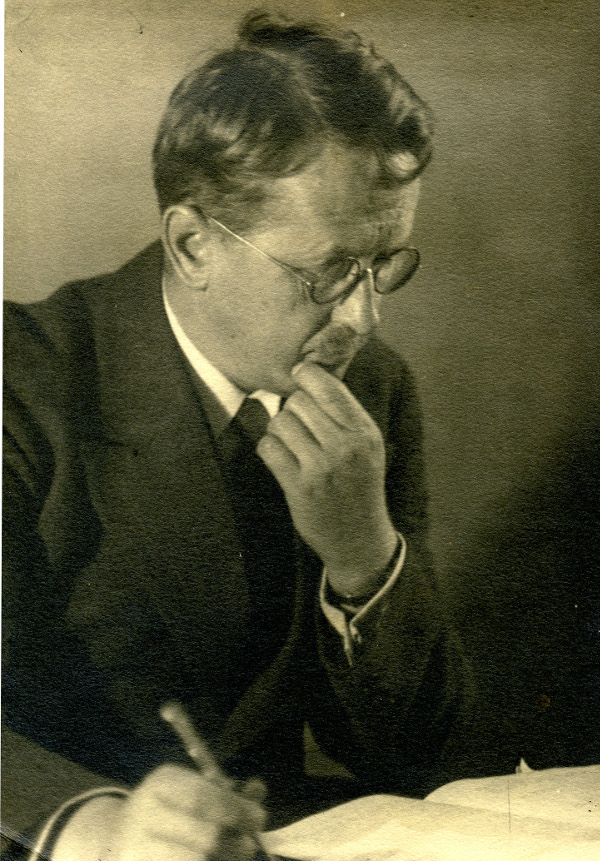
After studying at the Altsprachliches [Classical language] Gymnasium Christianeum [1] in the Altona district of Hamburg, which schooled him in the foundations of classical culture, Hermann Weyl began his mathematical studies at the University of Göttingen in 1904. In his obituary of Hilbert, written in 1944, Weyl mentions that he was able to enroll in the university of Göttingen thanks to the valuable support of the director of his high school, who was none other than Hilbert’s cousin [2].
We begin by examining how Weyl’s initial works reflect (at least partially) the complexity of subsisting mathematical practices at the University of Göttingen in the early years of the 20th century. Moreover, they also shed light on the tensions that existed between different mathematical schools of thought in Göttingen at the time, concerning the foundations of mathematical sciences. Weyl’s first works in pure mathematics are seen to have been influenced by three tutelary figures: David Hilbert (1862–1943), his mentor, Ernst Zermelo (1871–1953), who enthused him about recent advances in set theory, and Felix Klein (1849–1925), whose influence on him, though indirect, was equally important. It is important to allude to the legacy of Hermann Minkowski, who also had a crucial influence on Weyl, and whose work inspired Weyl’s interest in the geometrization of relativity theory. However, in the interest of brevity, we omit further discussions on this topic.
We then discuss Weyl’s interest in a variety of epistemological, philosophical and pedagogical theories, such as the positivism of Ernst Mach, the phenomenology of Edmund Husserl and, finally, Klein’s reflections on the status of mathematical knowledge and the teaching practices of mathematicians.
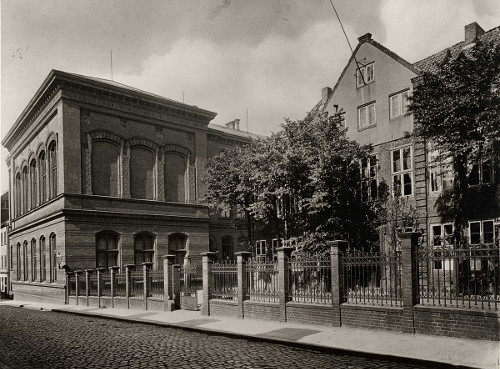
To begin with, we discuss the importance of Hilbert’s mathematical work during Weyl’s formative years. We will show that the work of Zermelo convinced Weyl to construct a rigorous basis for set theory. We will then elaborate on Weyl’s participation in Klein’s seminar on psychology and mathematics during the winter semester of 1909–1910. Lastly, we assess the impact of Klein’s pedagogical and epistemological views on Weyl’s early work.
Studying Hilbert and Defending Zermelo
Upon admission to the University of Göttingen, Weyl decided to take the advanced courses taught by Hilbert on topics such as number theory and quadratures of the circle [3]. Although too technical for young Weyl, these courses immediately inspired him to read some of Hilbert’s non-trivial mathematical contributions. Thus, at the end of his first year of study, Weyl obtained a copy of the Zahlbericht, Hilbert’s voluminous work on the algebraic theory of numbers (1897) [4].
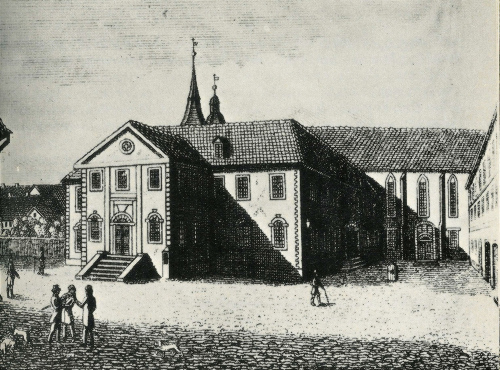
Weyl began his early research in the theory of integral equations, comprising topics that were in line with Hilbert’s research during the period 1903–1912. Hilbert later relied on this theory to launch a major program to unify analysis and algebra. His investigations were extended by several of his students, including Erhard Schmidt, Hellinger and Toeplitz. Weyl too decided to devote his doctoral thesis, which he defended in 1908, to integral equations under the direction of Hilbert [5]. He continued his investigations in this field, with extensions to ordinary differential equations and applications to problems of mathematical physics, which were included in his habilitation thesis1 [Habilitationsschrift] (1910).
As a parallel line of thought, his habilitation thesis [6] sheds light on an epistemological problem concerning the status of the definitions of concepts in mathematics. In particular, he refers to the definitions by abstraction which are based on the notion of equivalence relations, defined as follows.
Let E be a set, we call R\subset E\times E an equivalence relation on E if the following conditions hold:
- Reflexive: (x,x)\in R,~\forall x\in E
- Symmetric: (x,y)\in R \iff (y,x)\in R,~\forall x,y\in E
- Transitive: (x,y) \in R ~\text{and}~(y,z)\in R \implies (x,z)\in R,~\forall x,y,z\in E.
Weyl shows in his thesis that the most elementary mathematical concepts, starting with the parallelism between straight lines in the standard two-dimensional plane, are based on an equivalence relation. In particular, he exhibits that the straight lines in the plane can be divided into equivalence classes according to the relation “to be parallel to” and further into a second set of equivalence classes of directed straight lines where lines belong to the same class if they all have the same direction.
He also introduces another type of definition that Hilbert employed, particularly in his Grundlagen der Geometrie (1899). These are definitions which are implied by axioms [implizite Definitionen durch Axiome]. Here, a mathematical concept is defined by a list of axioms independent of each other, without being concerned about the nature of the objects which are likely to realize this same concept. Implicit definitions are meant in the sense that they do not refer to a specific object; we cannot therefore say a priori which mathematical object falls or does not fall under an implicitly defined concept. To illustrate this second type of definition, we can consider the notion of an abstract group, axiomatized definitively by H.~Weber in 1893 [7].
Formally, a non-empty set G taken together with an operation \star: G\times G\to G is called a group [8] if the following conditions hold:
- x\star(y\star z)=(x\star y)\star z,~\forall x,y,z\in G (Associativity)
- \exists e\in G such that e\star x=x\star e=x,~\forall x\in G
- For any x\in G,~\exists x^{-1}\in G such that x\star x^{-1}=e.
Merely reading this definition gives no idea about the great diversity of mathematical objects such as Lie groups, vector-spaces, modules, fields, rings, etc, that satisfy these three axioms but belong to distinct domains.
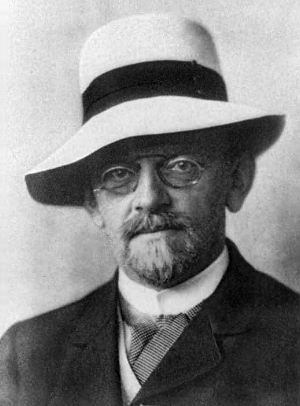
At the beginning of his habilitation thesis, Weyl almost literally paraphrases the first lines of Hilbert’s Grundlagen der Geometrie [The Foundations of Geometry]: points, lines, and planes must be considered as abstract objects designated by symbols; some relations between these objects are then introduced by a series of words (“to be located”, “between”, “parallel”, etc); finally, one must be able to deduce the propositions of geometry from a minimal set of axioms, which comprise the essential logical structure [9].
In his book, Hilbert does not reject any intuitive representation, but his intent is to rigorously analyze our intuitive notion of space by using two ingredients––the axiomatic method and a definite language—as evidenced by the mathematical language he introduces to establish relations between different geometric objects. An axiom for Hilbert is not an obvious truth; rather it is only a logical hypothesis that is primordial in the order of deduction of mathematical propositions, and is to be inserted in a system of axioms. The main purpose of the axiomatic system that Hilbert proposes in the Grundlagen der Geometrie was to formalize (and consequently be able to generalize) mathematical theories, in particular, Euclidean geometry. Note, however, that Hilbert’s goal was not only to identify the groups of axioms underlying this geometry, but also to analyze the logical properties of the system they form. This ensures that the axiomatic system does not lead to any contradictions, and also shows the independence of a given axiom by constructing a logically coherent system that does not involve it.
We can therefore identify, in pure mathematics, two functions of the axiomatic method in Hilbert’s work: (1) he uses it to define concepts, (2) he also relies on it to establish theories of mathematics and study their logical structure. In his mathematical practice, Weyl considers the axiomatic method primarily to define mathematical concepts. At the same time, certain passages of his habilitation thesis show that he was also interested in the axiomatic method as a means of establishing mathematical theories. This is evidenced by the fact that he refers to Hilbert’s Grundlagen der Geometrie and Zermelo’s contributions to set theory.
It should be recalled here that Zermelo defended his habilitation thesis in 1897, also at the University of Göttingen. Initially a Privatdozent, he received professorship in the same university in 1905. From 1900, he was interested in rigorously establishing the theory of sets. Almost at the same time, between 1897 and 1900, Hilbert had a correspondence with Cantor on the theory of sets; he gradually appropriated the ensemblist language and recognized the need to base this theory on solid foundations. This concern was shared by Hilbert and Zermelo who realized that the axiomatic method as used by Hilbert in his Grundlagen der Geometrie was the key to clarifying the theory of sets [10]. In a landmark article in 1908, Zermelo proposed a series of axioms that imposed enough constraints to shield this theory from any paradox while also being broad enough to include all areas of mathematics [11]. The elimination of paradoxes in set theory partly justifies the fact that Zermelo relied on the axiomatic method in his 1908 article [12]. He supposed that analysis and arithmetic derive entirely from the theory of sets, which is why the theory must be formulated in a perfectly rigorous manner. The axiomatic method was, in the eyes of Zermelo and Hilbert, an essential instrument for probing the logical structure of a theory and ensuring that it did not lead to any flaw in the reasoning.
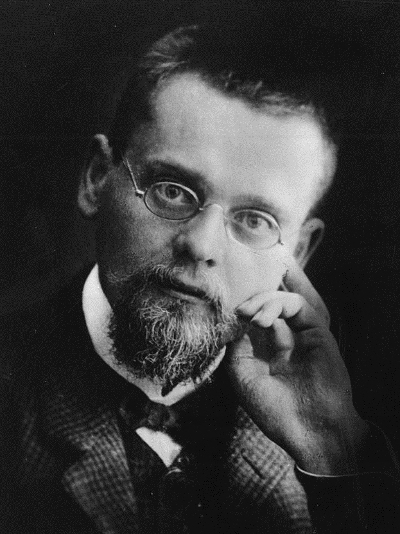
Returning to Weyl’s work, we can first assume that his habilitation thesis was an extension of Hilbert’s Grundlagen der Geometrie [13] and Zermelo’s decisive contributions in set theory. These were indeed an epitome of rigor at the University of Göttingen. We will see however at the end of this same text, Weyl’s reference to Klein, another very important figure of mathematics in Göttingen. Though the latter did not oppose the use of the axiomatic method in mathematics, he defended a conception of the mathematical sciences that was orthogonal to the points of view of Hilbert and Zermelo.
As a first consideration, we can say that the young Weyl worked essentially in the same vein as Hilbert in that he drew inspiration from the most diverse aspects of Hilbert’s work, mainly the theory of numbers, fields, the foundations of geometry (and mathematics in general), and the theory of integral equations. The monograph that Weyl published on Riemann surfaces in 1913 only confirms this point as he takes up the first rigorous definition of a topological surface proposed by Hilbert in two supplements to Grundlagen der Geometrie [15]. Weyl also relied on the axiomatic method to define Riemann surfaces in general, in the process of establishing that they are complex analytical manifolds of dimension one, and so on. Weyl thus borrowed from Hilbert, a method of definition via axioms, and a great variety of theoretical frameworks. In addition, Weyl enthusiastically defended Zermelo’s work in his habilitation thesis. For example, he writes in a note that “Zermelo is the only one to have proposed a system of axioms of set theory formulated in exact language.” [16]. The expression “exact language” refers to a requirement of rigour which makes it possible to neutralize the paradoxes arising from a naive theory of sets. Weyl did not cast a shadow of criticism on the foundations of mathematics when he was a student, and later Privatdozent, in Göttingen.
Klein’s Presence: Mathematics, Psychology and Positivism
From the above observations, our description of Weyl’s academic career in Göttingen would be simplistic. Our portrait does not reflect the various facets of a mathematician who, as his intellectual and scientific career progressed, was torn between a preference for rigour—particularly embodied by the promotion of the axiomatic method—and a constant reference to intuition fearing that the mathematical sciences could be reduced to meaningless combinations of symbols.
However, even while he was a Privatdozent in Göttingen, Weyl did not unreservedly defend the idea that the mathematical sciences must express themselves in a formally rigorous language. The reservations about this idea mainly came from Klein, who played a central role at the University of Göttingen, although his career as a mathematician was essentially behind him at that point. Several facts capture our attention in characterising Klein’s legacy in Weyl’s early work.
First, Weyl dedicated his work on Riemann surfaces to Klein. This dedication stemmed from the fact that, like Klein, Weyl considered Riemann surfaces as the basis for the study of functions of a complex variable. Klein’s influence on Weyl was deeper, more complex, and also more implicit than what this dedication suggested.
The following fact requires mention: during the winter semester of 1909–1910, Klein organized a seminar entitled “Mathematik und Psychologie” in which several Dozenten (speakers), including Weyl, participated. This seminar was devoted to epistemological and pedagogical reflections aimed at clarifying the psychological genesis of mathematical concepts and truths. Klein’s interest in psychology, especially in experimental psychology, was not new. Indeed, in his famous lecture on the arithmetization of mathematics (1895), Klein expressed his belief that psychological research would, in the future, explain the role and functions of intuition and logic in the construction of mathematical knowledge, summed up in the following words:
Perhaps one day experimental psychology will tell us exactly about the more intimate relationships that may exist between processes derived from intuition and those that are in the realm of logical power… We are hopeful that the many differences of opinion between science and its practice, differences which remain unshakable to this day, will disappear once we are fully informed about the psychological conditions of mathematical thought and the individual differences between them. [17]
The experimental psychology that Klein invokes in this passage consists in basing the study of sensations, effects, and intellectual processes on a scientific method. It is characterized by the empirical observation of individual behaviours and the study of the organic substrate—in this case the nervous and cerebral system—on which psychological reactions depend.
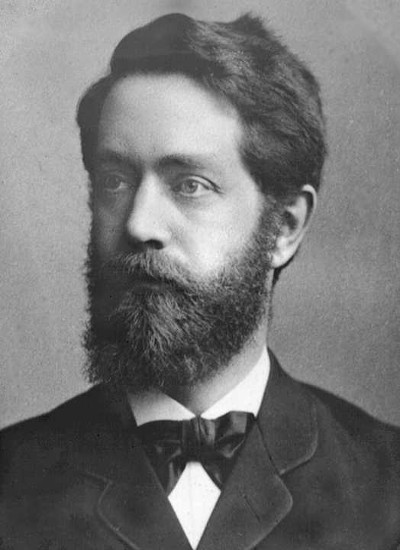
W. Wundt is considered the founder of experimental psychology in Germany. In 1879 he founded the first laboratory of experimental psychology at the University of Leipzig, where Klein was a professor from 1880 to 1886. It is therefore very likely that he became acquainted with the early developments of experimental psychology from this period. It should also be added that the development of experimental psychology must be linked to a certain form of positivism, that is to say, a philosophical premise according to which one must banish any questions regarding “why a certain hypothesis is true”, in order to accept it, and instead incline oneself towards a rational explanation of how observable phenomena occur. The advancement of the experimental method shows that experimental psychology is a positivist philosophy. In fact, Klein adhered to some form of positivism throughout his scientific career [18].
At the time when Weyl was a Privatdozent, Klein harboured a keen interest in experimental psychology. More generally, a positivist philosophy was prevalent among the other scientists at the University of Göttingen. In his seminars from 1909–1910 on psychology and mathematics, Klein placed experimental psychology on a high pedestal. In addition, in the early 1910s, he worked with psychologist D. Katz, who participated in 1913 in the collective work on mathematics education in Germany which was led by Klein. The chapter written by D. Katz is rightly entitled Psychologie et enseignement mathématique i.e. Psychology and Mathematical Education [19].
Returning to the 1909–1910 seminars, a summary of each session was reported by Klein in a notebook that is currently housed in the University of Göttingen Library. On 3 November 1909, Weyl presented a report on a vast international “survey” whose purpose was to describe “the method of work of mathematicians”. It was a questionnaire addressed to mathematicians in order to grasp their taste for mathematics, their way of practicing it, the psychological origins of their discoveries, their access to general truths, their daily lives and their work habits. There were about 100 respondents, all mathematicians by profession [20]. This questionnaire took up and generalized a first investigation led by the mathematician E. Maillet on the role of the unconscious representations in the practice of mathematics [21].
We list here some of the questions that made up the “Survey of the Method of Work of Mathematicians”:
1. At what time, according to your recollection, and in what circumstances did the taste for mathematical sciences take hold of you?
8. Have you ever noticed that discoveries or solutions, on a subject totally foreign to your current research, have appeared to you, while their pursuit had previously been unsuccessful?
9. Do you consider that your main discoveries were the results of a desired work, directed in a specific sense, or that they presented themselves to your mind spontaneously, so to speak?
14. When you address a question, do you seek to study in a general way (the more or less) precise problems that you ask yourself? Do you usually prefer to deal with special cases first, or an extended case and then generalize gradually? [22]
Some answers to this questionnaire were selected and disseminated in L’Enseignement mathèmatique between 1905 and 1908. They were then grouped together in a book published by Gauthier-Villars in 1908. This work was published under the direction of H. Fehr, a mathematics professor at the University of Geneva and co-founder with C.-A. Laisant of L’Enseignement mathématique [Mathematical Education]. In carrying out this project, Fehr was joined by two other colleagues, namely Th. Flournoy, professor of experimental psychology, and Ed. Claparède, director of the psychology laboratory in Geneva. This lent credence to the importance of experimental psychology in the description of mathematical knowledge and its genesis. Not only did Weyl attend Klein’s seminar on mathematics and psychology, but he also presented a synthesis of the famous “Inquiry” which was conducted by teachers of mathematics and professors of experimental psychology.
In Weyl’s own writings, published in 1910 and 1913, we find traces of his investment in Klein’s seminars. For example, in his habilitation thesis [23], as in his work on Riemann surfaces, he states that equivalence-based definitions derive their “psychological roots from the process of abstraction”. In other words, Weyl points here to a psychological process that would be the basis of a certain type of mathematical definition. These psychological considerations probably arose from his attendance of Klein’s seminars. Indeed, the main objective of these seminars was to describe all the psychological processes that accompany logical processes [24].
We have pointed out that experimental psychology goes hand in hand with a positivist philosophy which, according to Weyl’s testimony, was largely predominant among scientists at the University of Göttingen. In a lecture titled “Erkenntnis und Besinnung” [Knowledge and Reflection] at the University of Lausanne in May 1954, one year before his death, Weyl acknowledged his adherence to a certain form of positivism during his studies and in his first years as Privatdozent in Göttingen [25]. We can provide a two-fold explanation in this respect. On the one hand, as we have seen, Klein was a positivist. On the other hand, the work of the Austrian physicist and epistemologist E. Mach (1838–1916), one of the champions of positivism, was indeed authoritative in the eyes of young Weyl. Thus, in Chapter V of Mechanics [26], we get to read:
We must limit our physical sciences to the expression of observable facts, without constructing hypotheses behind these facts, where nothing exists that can be conceived or proved. So we simply have to discover the real dependencies of the mass displacement, temperature variations, variations of the potential function, chemical reactions, without imagining anything else under these elements, which are the physical characteristics directly or indirectly inherent in the observation [25].
We recognize in this argument, a form of positivism in the sense that Mach excludes from rational inquiry, any metaphysical consideration of the “why” of things. In addition, he bases scientific knowledge on the empirical observation of phenomena.
Let us now preemptively consider the fact that between 1913 and 1916, Weyl demonstrated a two-fold disengagement with the positivism of E. Mach and the experimental psychology to which Klein was attached. We can give two reasons for this development. Firstly, Weyl began to grow more and more interested in phenomenology thanks to his wife Helene, who was a pupil of Husserl in Göttingen. Now, without mentioning the outlines of Husserl’s phenomenology, it suffices to say that Husserl’s philosophical program supposed a prior rejection of all forms of psychologism and a refutation of E. Mach’s positivism. Husserl refers in particular to the epistemology of E. Mach, which he criticized up-front in his Guiding Ideas for a Phenomenology [27]. Secondly, Weyl was also interested in Fichte’s idealism in connection with his colleague, the philosopher Fritz Medicus at ETH Zürich. While engaging in Fichte’s philosophy in the years 1916–1921, Weyl moved away from positivist epistemology.
Klein’s Presence: Epistemology and Pedagogy
We have shown that Weyl adopted to a certain extent, the contributions of Hilbert and Zermelo between 1910 and 1913. He also recognized the need to rigorously base analysis by relying on the methods of Weierstrass and on topology. Referring to the latest advances in set theory, he feared that this requirement of rigour would become an end in itself. In addition, the methodology followed by Weyl in handling his classes show that he was very sensitive to Klein’s teaching requirements. This is why we think it is necessary to detail this aspect of the Klein legacy to complete the portrait of young Weyl and better understand the rigorous nature of his years of training at the University of Göttingen. At the beginning of his monograph on Riemann surfaces, Weyl mentions that his book contains the content of a course conducted during the winter semester of 1911–1912, whose main motive was, to put it in Weyl’s [28] own words,
to develop Riemann’s fundamental ideas in function theory [of a complex variable] in a form that satisfies all modern requirements in terms of rigour. This rigorous presentation, which does not appeal to intuition, but which gives exact proofs from the theory of sets, in support of the fundamental concepts and propositions of the analysis situs in the theory of functions, is still to be done.
But, a few lines later, the tone of his argument is a little different [29]:
We can not deny, that on the one hand, the discovery of a level of generality that goes far beyond our representations of the concepts of “function”, “curves”, etc.; and on the other hand, the use of logical rigour, as salutary as they are for our science, have also had undesirable effects in the development of contemporary mathematics.
Weyl recognized that the axiomatic method and a well-defined symbolic language allow us to eliminate certain confusions engendered by our intuitions, but logical rigor can not be its own end because it would not suffice to produce any new mathematical knowledge. Furthermore, he believed that our mathematical concepts have become so general that they could seem devoid of meaning or appear unrelated to particular objects arising from our own intuition. One can also find an argument of the same kind in the final remarks of his habilitation thesis. The question, therefore, is to understand the source of this skepticism against a tendency towards formalism that ultimately seeks to provide a simpler means (by the demands of rigour) and to manipulate certain concepts whose level of generality is so high that they no longer seem to have any meaning. In order to answer this seemingly difficult question, it would be apt to examine the metaphor used by Weyl at the end of his habilitation thesis to describe the mathematical sciences:
I believe that the human mind cannot rise to the level of mathematical concepts other than by shaping the given reality. The applicability of our science appears as a symptom of its roots and not as a true measure of its value; it would be fatal for mathematics that this tree proudly displays its broad peak in the sky but which, at the same time, drawing its strength through its many roots in the soil of intuitions and real representations, is pruned by very narrow utilitarianism or that it is torn from the very ground from which it arises. [30]
This metaphorical image is not new; it was used by Klein in a famous lecture he gave in Göttingen in 1895 under the title “Über Arithmetisierung der Mathematik” [On the Arithmetization of Mathematics] [31]:
I compare mathematical science to a tree whose roots sink ever more deeply into the ground, while above the leaves extend freely and shade us. Should we look at roots or branches as the most essential part? The botanist teaches us that the question is wrong and that the life of the organism rather depends on the mutual symbiosis between its different parts.
The proximity between the ideas of Klein and Weyl is evident here and deserves comment. By the above metaphor, they emphasize the complementarity between logical rigour and the search for generality on the one hand, and the “refined” intuition and the study of particular objects on the other. Refined intuition is acquired in the course of a regular practice of mathematics, and so it has nothing in common with mere presentiments or unmanifest impressions; and thus, different from the naive intuition which leads to conceptual confusions, pitfalls in reasoning and, in particular, to generalizations of no consequence. Klein’s idea of mathematical arithmetization is a complex process of reducing the mathematical sciences to the elementary operations of arithmetic and endowing them with a true logical rigour. Klein associates with this process, mathematicians as different as Weierstrass, Kronecker, Peano and Cantor.
Although they recognize the need, Weyl and Klein express a certain reserve with regard to this mathematical arithmetization. While they find that it facilitates avoiding errors and confusions, it is insufficient to produce new knowledge in mathematics. This explains the importance of a “refined” intuition which, according to Klein, has a double advantage in that—not only does it get rid of the defects of naive intuition but also guarantees a veritable “content” to mathematical knowledge.
It should be noted, however, that at the end of his habilitation thesis, Weyl does not merely explain Klein’s metaphor, but rejects back-to-back two diametrically opposed or conflicting inconsistencies that would have been “fatal” for mathematics. On the one hand, he noted that mathematical ideas cannot be reduced to an ethereal formalism, where generality and rigour become ends in themselves. This is the perverse effect of “arithmetization of mathematics”, which leads to a total disconnect with refined intuition. On the other hand, Weyl also criticizes upfront a utilitarian drift which consists in evaluating the mathematical sciences only by their empirical, technical and industrial applications. This shows that Weyl did not blindly paraphrase Klein at the end of his habilitation thesis.
Thus with regards to Klein, while on the one hand Weyl did subscribe to the idea of a complementarity between logic and intuition, on the other hand, from an institutional and political point of view, he distanced himself from Klein’s great project of systematically bringing the mathematical and physical sciences closer to industry. For example, the “Göttinger Vereinigung zur Förderung der angewandten Physik” [Göttingen Applied Physics Support Association] was founded in 1898 and was extended to cover applied mathematics in 1900. This was the culmination of a project initiated by Klein, which he carried out by surrounding himself with industrialists such as Henry Theodore Böttinger, who specialized in the chemical industry [32]. Thus, criticizing all forms of utilitarianism, the young Weyl distanced himself from the Kleinian inheritance from both an institutional and a political point of view, while he did take it up on an epistemological level.
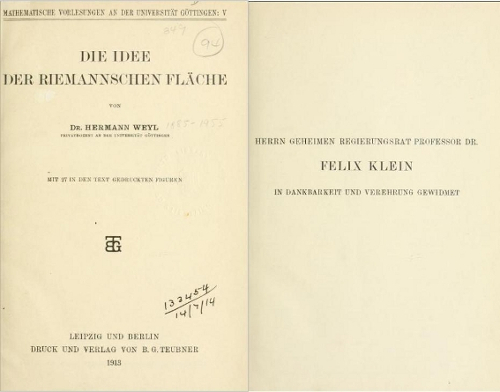
Finally, in the very organization of his courses in complex analysis (1910–1911) and on Riemann surfaces (1911–1912), Weyl at least partially followed Klein’s teaching requirements in universities. It is therefore necessary to summarize briefly Klein’s reflections on a pedagogical plan and then show how Weyl appropriately adopted them.
In a report presented to a scientific congress in Breslau in September 1904, Klein formulated four requirements in the organization of the content of a course in mathematics: (1) the use of a genetic or constructive method, based on the study of particular objects or intuitively comprehensible situations before adopting a deductive argument guided by the axiomatic method; (2) the use of spatial intuitions to allow students to “visualize” the concepts and objects which they are thinking about; (3) the need to refer to applications in the natural sciences—especially in physics—as soon as possible; and (4) a progressive introduction of the “logical element” to counter possible confusions generated by naive intuition [33].
In other words, Klein considered it impossible for an introductory course to meet all these requirements in terms of rigour, which could not be assimilated immediately by most students.
I leave complete freedom to each academic Dozent, and therefore, I have always countermanded the general rules for higher mathematics education. This does not prevent me from affirming strongly that there are, in any case, two categories of courses in mathematics which must necessarily take their point of departure in intuition. These are firstly the elementary courses, which prepare the beginner for learning higher mathematics; for the master must, in accordance with the nature of things, go in a small way to the same path of development that Science has followed in a grand way. Then there are the courses… for those who study the sciences of nature and for the engineers. [34]
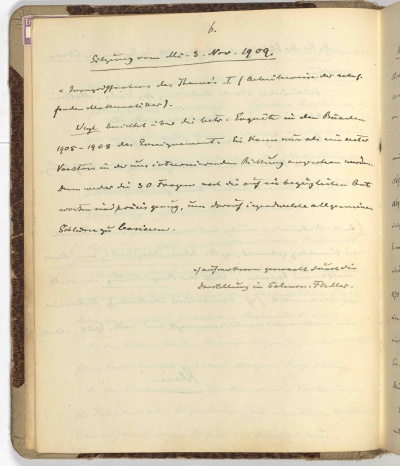
Weyl proposed in 1910–1911 an introductory course in complex analysis that satisfied these requirements [35],where certain mathematical concepts are only introduced during a detailed study of particular functions. An important place was given to physical-geometrical representations, according to the mode of presentation adopted by Klein in his course on the algebraic functions of a complex variable [36].
In a chapter in La valeur de la science [The Value of Science] devoted to intuition and logic in mathematics, Henri Poincaré relies on the Kleinian approach in complex analysis to classify the German mathematician as a “geometer” as opposed to an “analyst”. Poincaré states:
[Mr. Klein] studies one of the most abstract questions of the theory of functions; it is a question of determining whether on a given Riemann surface, there always exists a function admitting given singularities. What does the famous German geometer do? He replaces the Riemann surface with a metal surface whose electrical conductivity varies according to certain laws. He puts two of his points in communication with the two poles of a battery. It will be necessary, he says, that the current passes, and the way this current will be distributed on the surface will define a function whose singularities will precisely be those which are determined by the conductivity function. No doubt Klein knows well that he has only given a glimpse of it: it is true that he did not hesitate to publish it; and he probably thought he would find, if not a rigorous demonstration, at least some moral certainty. [36]
Poincaré insisted that such an approach, based on physical intuitions, would be rejected as non-rigorous by “logicians” or “analysts” in so far as the existence of such a function was not mathematically proven. Yet, as S. Patterson points out in the preface to Weyl’s course on function theory, Weyl recognizes the merits and relevance of Klein’s approach in introducing students to the study of the functions of a complex variable. Weyl also relies on intuitive representations to introduce the notion of Riemann surface at the very end of this elementary course.
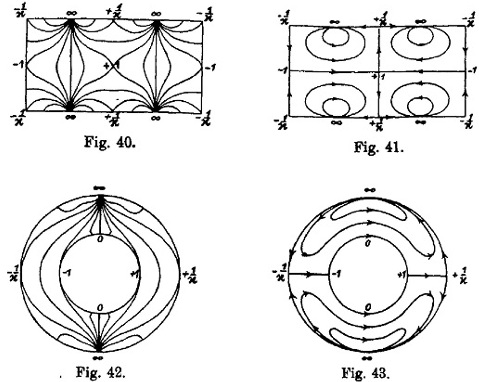
Weyl, Student of Hilbert and Klein
The mathematical work of the young Weyl partially reflects the complexity that was prevalent in the very institution which shaped his mathematical makeup, namely the University of Göttingen. In his habilitation thesis, he recognized the value of Zermelo’s work to axiomatize set theory. From the point of view of research, the habilitation thesis is in the same vein as that of Hilbert, a fact evidenced by his work on integral equations. We further showed that Weyl was influenced by a wide assortment of Hilbert’s works, be it Zahlbericht or Grundlagen der Geometry. It would be overly reductive, however, to picture Weyl as a pupil of only Hilbert and nothing more during his Göttingen years. Indeed, from an epistemological and pedagogical point of view, we have shown that the influence of Klein on Weyl was equally significant as together with Klein, Weyl recognized the importance of incorporating physical-geometrical representations in introductory courses on higher mathematics. Moreover, the same is consistent with Klein’s reservations about the process of the arithmetization of mathematics.
References
- [1] In the German school system, an “altsprachliches Gymnasium” is a secondary school in which the teaching of ancient languages—Latin and Greek—is part of the compulsory curriculum of pupils.
- [2] H. Weyl. David Hilbert and his mathematical work. Bulletin of the American Mathematical Society. 50, (1944), p. 614.
- [3] Ibid., P. 614.
- [4] D. Hilbert. Die Theorie der algebraischen Zahlkorper. Jahresbericht der Deutschen Mathematiker-Vereinigung. 4, 1897, p. 175-546.
- [5] H. Weyl. “Singuläre Integralgleichungen mit besonderer Berücksichtigung des Fourierschen Integral theorems”, Doctoral Thesis, Göttingen 1908, in Gesammelte Abhandlungen (GA), Bd. I, Berlin, ed. Springer, 1968, p. 1–87.
- [6] H. Weyl. “Über die Definitionen der mathematischen Grundbegriffe”, Enabling Lesson, Mathematisch-naturwissenschaftliche Blätter, 7, 1910, GA. I, p. 298-304, “On Definitions of Fundamental Mathematical Concepts”, in The Continuum and Other Writings, Translated and Annotated by J. Largeault, Paris, ed. Vrin, 1994, p. 20 to 32.
- [7] H. Weber. Die allgemeinen Grundlagen der Galoisschen Gleichungstheorie [The general foundations of the Galois theory of equations], Mathematische Annalen 43, 1893, p. 521–549.
- [8] Caroline Ehrhardt. Un Concept Mathématique, Trois Notions : Les Groupes Au XIX^{e} Siècle Chez Galois, Cayley, Dedekind
- [9] D. Hilbert. Die Grundlagen der Geometrie (1899), second edition, Leipzig, ed. Teubner, 1903, p. 1.
- [10] For more details, cf. V. Peckhaus. Pro and Contra Hilbert: Zermelo’s set theory. Philosophia Scientiae, cahier spécial 5, 2005, p. 202 to 207.
- [11] E. Zermelo. Untersuchungen über die Grundlagen der Mengenlehre. Mathematische Annalen. 65, 1908, p. 261-281.
- [12] For a more complete synthesis of Zermelo’s article, see in particular F. Longy, “Mathematics and intuitions: Zermelo and Poincaré versus the axiomatic theory of sets and the axiom of choice”, Philosophia Scientiae, 5, 2001, p. 54: “At the origin of the axiomatization of the set theory is found at least as much the need for Zermelo to justify its `axiom of choice’ as the desire to eliminate paradoxes that would undermine the Cantorian theory of sets.”
- [13] H. Weyl. On Definitions of Fundamental Mathematical Concepts. op. cit., p. 21.
- [15] D. Hilbert. Über die Grundlagen der Geometrie. Mathematische Annalen. 56, p. 234-235.
- [15] H. Weyl. On Definitions of Fundamental Mathematical Concepts. op. cit., p. 30.
- [16] F. Klein. On the arithmetization of mathematics. (1895), New Annals of Mathematics. 16, third series, 1897, p. 126.
- [17] See in this connection D. Rowe. Klein, Hilbert and the Göttingen mathematical tradition. Osiris, 2nd Series, Vol. 5, 1989, p. 188.
- [18] D. Katz. Psychology and Mathematics Unterricht, in. F. Klein (ed.), Abhandlungen über den mathematischen Unterricht in Deutschland, Bd. III, H. 8, IV, Leipzig, ed. Teubner 1913. Katz’s work is taken from a series of volumes devoted to the teaching of mathematics in Germany, the publication of which begins in 1910. To clarify the reasons for these volumes, let us recall that the International Commission for mathematical education was created at the International Congress of Mathematicians held in Rome in 1908. It was chaired by F. Klein. The purpose of this commission was to compare the situation of mathematics education in various states. Katz’s book is part of the volumes initiated by Klein to take stock of the teaching of mathematics specifically in Germany.
- [19] Among the mathematicians who answered this questionnaire, we can mention the names of L. Boltzmann, L.-E. Dickson, C. Meray, E. Maillet, C.-A. Laisant, H. Fehr, Moritz Cantor, etc.
- [20] E. Maillet (engineer of the bridges and roads, coach at the Ecole Polytechnique). “The dreams and the mathematical inspiration”, in Bulletin of the Philomathic Society, ninth series, Volume VII, first booklet, p. 19 to 62. The Maillet questionnaire survey is intended for mathematicians who have at least ten years of experience in the practice of mathematics. Maillet reports in extenso some of the answers provided to him, sometimes on condition of anonymity. These are supposed to enlighten us on the “psychology of mathematicians”. In a footnote, Maillet refers to the Survey of the Method of Work of Mathematicians, which has just been initiated.
- [21] The Survey of the Method of Work of Mathematicians. questionnaire published in Mathematical Education, 1902, p. 208 to 210.
- [22] H. Weyl. Über die Definitionen der mathematischen Grundbegriffe. op. cit., p. 303.
- [23] Felix Klein. Seminarprotokolle Winter 1909-1910, Psychology and Mathematics, p. 1.
- [24] H. Weyl. “Erkenntnis und Besinnung”, Studia Philosophica 15, 1955, GA, Bd. IV, op. cit., p. 631-649; an English translation of this lecture is found in H. Weyl, Mind and Nature, Princeton, 2009; see p. 208 and 209 for the passages concerning the Weyl’s adherence to the positivism of E. Mach.
- [25] E. Mach. Mechanics (1883 for the first edition) trans. of the fourth edition (1901) by E. Bertrand, Paris, ed. Hermann, 1904, p. 466.
- [26] E. Husserl. Ideas Pertaining to a Pure Phenomenology and to a Phenomenological Philosophy (1913), translation of the third edition (1928) by Ricœur, Paris, ed. Gallimard, 1950, p. 79-80.
- [27] H. Weyl. Die Idee der Riemannschen Fläche [The surface idea of Riemann], Leipzig, ed. Teubner, 1913, p. V.
- [28] Ibid., P. VI.
- [29] H. Weyl, Über die Definitionen der mathematischen Grundbegriffe. op. cit., p. 304.
- [30] F. Klein. On the arithmetization of mathematics. op. cit., p. 128.
- [31] For more details, see in particular H. Mehrtens. Moderne Sprache Mathematik, Frankfurt am Main, ed. Suhrkamp, 1990, p. 386.
- [32] F. Klein. Bericht an die Breslauer Naturforscherversammlung über den Stand des mathematischen and Physikalischen Unterrichts an den höheren Schulen [Report on the state of mathematics and physics education in higher schools—universities, schools engineers, etc.—in front of the Congress of Natural Science Researchers in Breslau]. Jahresbericht der Deutschen Mathematiker-Vereinigung, XIV, issue 1, p. 38.
- [33] F. Klein. On the arithmetization of mathematics. op. cit., p. 127.
- [34] H. Weyl. Einführung in die Funktionentheorie [Introduction to Function Theory], course taught during the winter semester 1910–1911 in Göttingen, transcribed under the direction of R. Meyer and S.J. Patterson, Basel, ed. Birkhäuser, 2008.
- [35] F. Klein. Über Riemanns Theorie der algebraischen Funktionen und ihrer Integrale [On the Riemannian Theory of Algebraic Functions and Their Integrals], Leipzig, ed. Teubner, 1882.
- [36] H. Poincaré. The role of intuition and logic in mathematics. Proceedings of the Second International Congress of Mathematicians (1900), p. 116, reproduced in The Value of Science, (1905), Paris, ed. Flammarion, 1970, p. 28.
Footnotes
- In several European countries, defense of the Habilitation thesis, a few years after the PhD thesis, is the highest level of academic examination conducted in order to gauge the depth of understanding and original thinking in a particular field, and is a necessary qualification for obtaining a teaching position in reputed universities ↩
